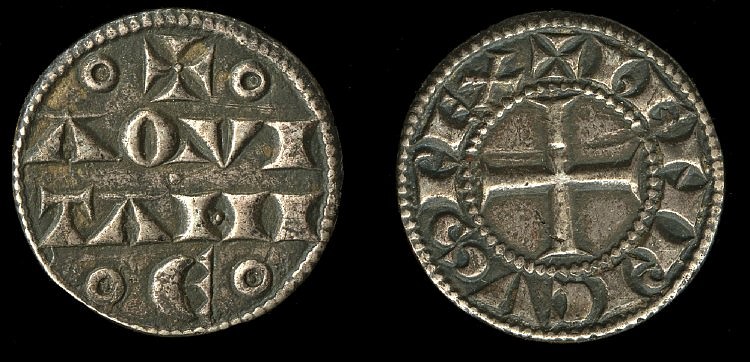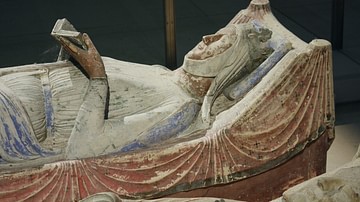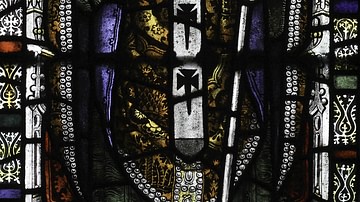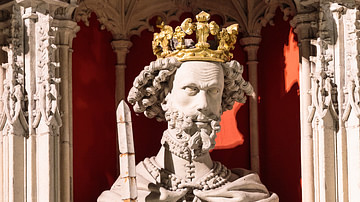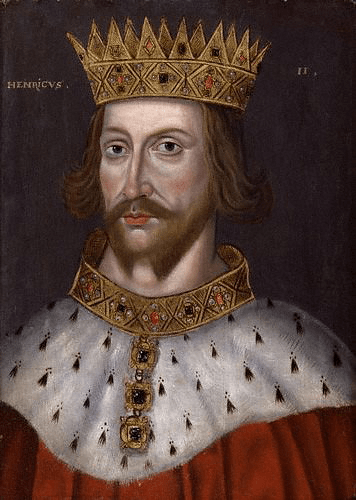
Henry II of England ruled from 1154 to 1189 CE. He gained the throne by negotiation with his predecessor King Stephen of England (r. 1135-1154 CE) following the civil war that had raged between that monarch and Henry's mother Empress Matilda (l. 1102-1167 CE). Henry would begin a new ruling dynasty, the Angevins-Plantagenets, and he would rule until 1189 CE, forming the largest 'empire' in western Europe and establishing himself as one of England's greatest ever kings. Two black marks which became impossible to erase from memory, however, were the murder of his chancellor and then archbishop, Thomas Becket in 1170 CE and the rebellions led by his own sons at the end of his reign. Henry was succeeded by his son Richard I of England, aka Richard 'the Lionheart' (r. 1189-1199 CE) and then his other son King John of England (r. 1199-1216 CE).
Early Life - The Plantagenets
Henry of Anjou was born on 5 March 1133 CE at Le Mans, France, the son of Geoffrey, Count of Anjou (l. 1113-1151 CE). Henry's mother was Empress Matilda, the daughter of Henry I of England (r. 1100-1135 CE), who had gained her title when marrying her first husband Holy Roman Emperor Henry V (r. 1111-1125 CE) in 1114 CE. After Henry V's death, Matilda married again, this time to Geoffrey in 1128 CE. The count became known by the nickname 'Plantagenet' because his family coat of arms included the broom plant (planta genista). Alternative theories for the origin of the name are that Count Geoffrey wore sprigs of the plant in his hat or his lands were planted with it to provide good cover while hunting. The Plantagenets (1154-1399 CE) did not, of course, call themselves that name, the monarchs carried no surname. The first three kings of the line - Henry II, Richard I, and King John - are sometimes referred to as the Angevins after their ancestral lands in Anjou in north-west France.
Henry II was known for his good looks, intelligence, and ability to speak several languages. Credited with boundless energy and drive, the king was of stocky build and had piercing grey eyes, red hair, and a ferocious temper to match. In later life, he was said to have had a significant paunch.

Henry inherited his father's lands in Normandy, Anjou, Touraine, and Maine in 1151 CE, but he was ambitious for much more. Following military victories in Brittany and, in May 1152 CE, his marriage to Eleanor of Aquitaine (c. 1122-1204 CE), the former wife of Louis VII of France (r. 1137-1180 CE), Henry came to control most of France. Henry was ambitious, too, to control England, weakened as it was by years of civil war. He and Eleanor would have eight children which included Richard I the 'Lionheart' or Coeur de Lion (b. 1157 CE), Geoffrey, Count of Brittany (b. 1158 CE), Henry the Young King (b. 1155 CE, who reigned as junior king, 1170-1183 CE) and King John of England (b. 1167 CE).
King Stephen, Empress Matilda & Succession
Returning back to 1135 CE, King Henry I of England had left no legitimate male heir and so his nominated successor was his daughter Matilda whom the king had made his barons swear loyalty to. When it came to the actual coronation, though, many barons wanted neither a woman or an Anjou count anywhere near the throne and so supported instead the dead king's nephew and richest man in England, Stephen of Blois. Consequently, with some sharp manoeuvring, Stephen was crowned king in December 1135 CE. Empress Matilda was undeterred and a civil war broke out between barons who supported Stephen and those who favoured Matilda and her chief ally Robert Fitzroy, Earl of Gloucester, an illegitimate son of Henry I. The war proved long and damaging, and neither side managed to gain the upper-hand, even if Matilda briefly became queen in 1141 CE while Stephen was imprisoned at Bristol. Matilda's cause was gravely weakened following the death of Robert Fitzroy in 1147 CE and she now focused her attention on the promotion of her son Henry.
Henry attempted an invasion of England in 1147 CE, but his campaign came to an end when he ran out of funds, obliging his return to Normandy. Rather bizarrely, but entirely in keeping with Stephen's reputation for clemency, the English king paid for Henry's trip home. Another attack in 1149 CE, this time in the north of England and with the assistance of David I of Scotland (r. 1124-1153 CE), was defeated by an army of Stephen's. At least Henry did not completely waste his time as he was knighted by the Scottish king. In any case, Henry could bide his time and once he had much greater resources at his disposal, he tried another invasion in 1153 CE which, third time lucky, finally brought an end to the civil war.
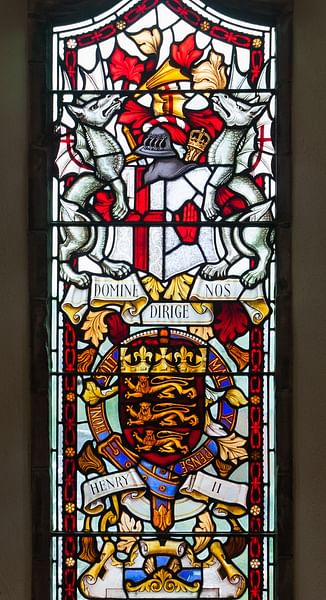
In 1153 CE, King Stephen was something of a broken man following the death of his wife and son Eustace (b. 1127 CE) that year. He now faced Henry's third invasion and hoped for a decisive pitched battle, but in the event, neither side's soldiers or leaders were very keen on a fight. Consequently, on 6 November, Stephen signed with Henry the Treaty of Wallingford, which recognised him as Stephen's official heir. In return, Stephen was allowed to keep his crown for the rest of his life. The barons had no better candidate to support than Henry, and it was clear to all that the civil war had not done anybody any good (even if its chaos has perhaps been exaggerated by later historians) and the last thing England needed was another tussle for the throne. As one anonymous medieval chronicler put it, "For nineteen long winters, God and his angels slept" (quoted in McDowall, 26). It was time for unity and peace. Consequently, when Stephen died on 25 October 1154 CE at Dover in Kent, Henry was crowned on 19 December 1154 CE at Westminster Abbey, and he became the first undisputed king of England for over a century.
Consolidating Royal Power
Henry's first important task was to bring the Anglo-Norman barons back into line after the period of civil war in England (1135-1153 CE) had enabled them to largely ignore royal authority and build castles, mint their own coinage, and generally deal with the peasantry how they wished without regard to the law. Many castles built in that period were of a temporary nature and not large stone edifices, but Henry was so determined to destroy them he gained the nickname the 'castle-breaker.' Some of the stronger and older castles he kept for himself such as Scarborough Castle, Nottingham Castle, Norwich Castle, and Castle Acre. To better ensure the law was equally applied everywhere in the country - a process begun by Henry I - the Assizes of Clarendon established in 1166 CE principles of Common Law, crown courts were set up, and trial by a jury of 12 men was established to punish those who broke it.
A second area where royal power had been eroded was the borders of England. Both Scottish and Welsh rulers had taken advantage of King Stephen's preoccupation with Empress Matilda to increase their domains. Henry negotiated the return of Cumbria and Northumbria from Malcolm IV of Scotland (1153-1165 CE) but conferred on him the earldom of Huntingdon and allowed the Scottish king to keep the castle at Wark-upon-Tyne in 1157 CE. The Welsh princes, especially Owain Gwynedd (r. 1137-1170 CE), required a more militaristic approach but Henry achieved his aim of reasserting his authority in the west of his kingdom. From 1171 CE a series of invasions were launched in Ireland against the dangerous baron Richard FitzGilbert (aka Strongbow). Eventually, the king's youngest son John was sent to rule there in place of the traditional High King (Ard Ri).
Treaties then formally recognised Henry's overlordship over Wales (1163 CE), Scotland (1174 CE), and Ireland (1175 CE). Henry was further boosted by the support of Pope Adrian IV (r. 1154-1159 CE) who gave formal recognition of the English king's authority over all of Britain and Ireland. The king also maintained his interest in France, indeed, he would spend 20 of his 35 years as king outside England.
Thomas Becket
A third area where Henry sought to reaffirm the power of the monarchy was its relationship with the medieval Church. The Archbishop of Canterbury, Thomas Becket (in office 1162-1170 CE), who had also been the chancellor (from 1155 CE) and a great friend of the king, proved troublesome, and his murder in 1170 CE would overshadow Henry's reign both at the time and ever since. Thomas had tried to defend the Church's independence and block the Crown's attempts to extract taxes from its lands and interfere in appointments. Neither side would budge and, in 1164 CE, Thomas was obliged to flee to a Cistercian monastery in France. Six years later, Thomas returned to England in early December 1170 CE to recrown Henry the Young King after the Pope had decided the original coronation, in which the Archbishop of York had performed the ceremony, was void.
On his return to England Thomas immediately began to suspend or excommunicate those bishops who had not supported him against the king. When Henry remarked 'Will no one rid me of this turbulent priest?' four knights took this as a literal order and so they searched out and murdered Thomas while he was praying in Canterbury Cathedral on 29 December 1170 CE. The murder shocked the establishment, and the Pope even made Thomas into a saint in 1173 CE. Fortunately for Henry, Papal legates found the king innocent of Thomas' death, although in 1174 CE he did have to perform a symbolic act of penance by visiting the dead archbishop's tomb in the cathedral in which he was murdered; monks armed with branches performed a penitential flogging of the king for good measure.
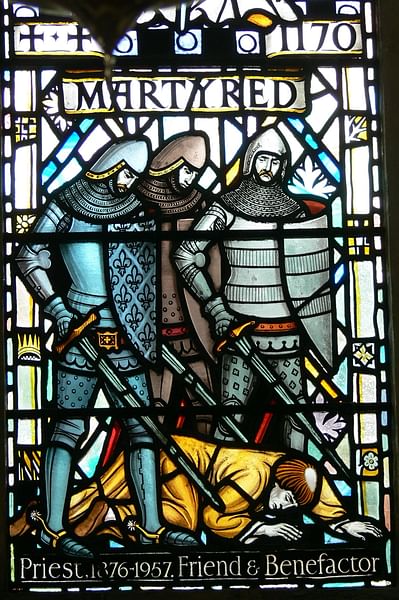
Rebellion
1173 CE proved to be quite a bad year for the king as his sons and wife rebelled against his rule from this point onwards. Eleanor of Aquitaine had become increasingly exasperated by her husband's unwillingness to delegate any real power to her and his infidelity, especially his public relationship with the noblewoman Rosamund Clifford (d. 1176 CE), famed for her beauty. Around 1170 CE Eleanor effectively separated from her husband and set up her own court in Poitiers. Her favourite son Richard went with her.
Meanwhile, Henry, well aware of the succession problems that had bedevilled his Norman predecessors, tried to cover himself as best he could by not only nominating his eldest son Henry as his successor but even having him crowned king-designate in 1170 CE, as we have seen (and again in 1173 CE to be absolutely sure). This was a common enough policy amongst French sovereigns and is why the heir is often referred to as Henry the Young King. Besides becoming king of England, the younger Henry was also to acquire the family lands in Anjou and Normandy. The other three sons Richard, Geoffrey, and John, were to receive Aquitaine, Brittany and Ireland respectively. All these careful plans were then thrown out of the window when in 1173 CE the young Henry, Eleanor, and several prominent barons upset over Thomas Becket's murder launched an 18-month rebellion against the king.
Despite the rebels having Sir William Marshal (c. 1146-1219 CE) on their side, often described as the greatest ever medieval knight, as well as Richard, who would earn himself a reputation as a great military leader, and his brother Geoffrey and William the Lion of Scotland (r. 1165-1214 CE), the rebellion was quashed by the end of 1174 CE. The king's preoccupation with castles had paid dividends. The trouble was a great expense for the crown, though, with huge sums of money spent on strengthening such key fortresses as Windsor Castle and Dover Castle amongst many others and building the technologically advanced Orford Castle in Suffolk. After the rebellion, Eleanor was imprisoned in various castles, only to be released in 1184 CE. Henry the Young King died of dysentery on 11 June 1183 CE. Geoffrey then died in an accident at a medieval tournament on 19 August 1186 CE, leaving Richard as the heir to the English throne despite the fact John had been (seemingly) the only one loyal to his father.
Richard remained impatient, though, and was not quite finished with his schemes to replace his father. In mid-1189 CE he joined forces with Philip II of France (aka Philip Augustus, r. 1180-1223 CE) - technically Richard's feudal overlord of his lands in France - and the pair were even supported by John against his father. Henry II, with everyone against him, was thus obliged to sign a peace deal and formally recognise the French king as his overlord regarding those lands he still held in France and to nominate Richard as his heir in England.
Death & Successor
Henry died of natural causes on 6 July 1189 CE at Chinon Castle, Anjou. Betrayed by his own nearest and dearest, legend has it the king's dying words were 'Shame, shame on a vanquished king'. The dead monarch was buried at Fontevraud Abbey in France. Henry, as agreed, was succeeded by his son Richard who was crowned on 2 September 1189 CE at Westminster Abbey. The kingdom still faced a serious threat from the scheming Philip II who was ambitious to expand his own territory. Philip conspired with John to make him king instead of Richard while the latter was away on the Third Crusade (1189-1192 CE) and then held in captivity by Henry VI, Holy Roman Emperor (r. 1191-1197 CE). Richard was freed two years later thanks to the payment of a ransom organised by his mother but when he died in battle in 1199 CE, John did at last become king, reigning until 1216 CE. In all, and albeit under different house names after 1399 CE, the Plantagenets would see 14 kings rule England for 331 years, making them the longest-lasting royal dynasty in the country's history.
